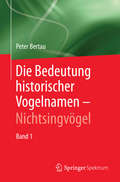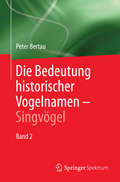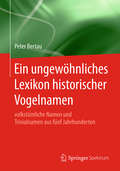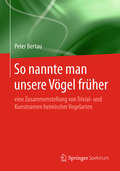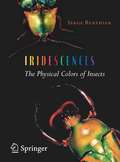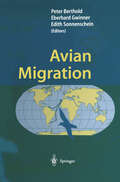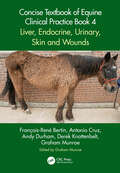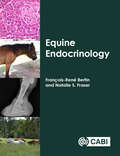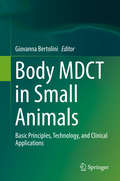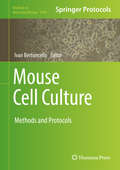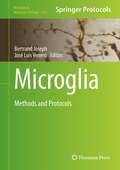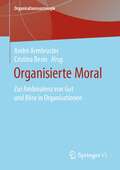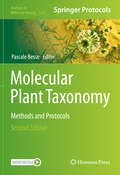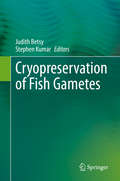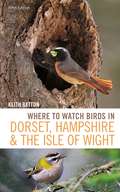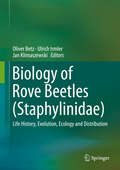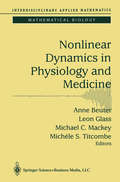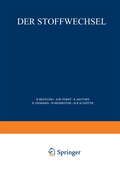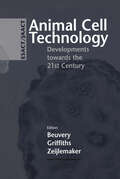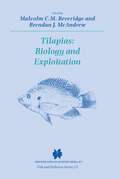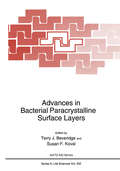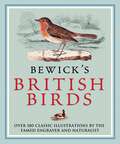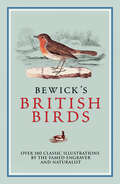- Table View
- List View
Die Bedeutung historischer Vogelnamen - Nichtsingvögel: Band 1
by Peter BertauFast jedes bis ins frühe 20. Jahrhundert erschienene Buch über Vögel enthält neben den damals üblichen wissenschaftlichen viele volkstümliche, sogenannte Trivialnamen. Der Autor Peter Bertau, ehemaliger Biologielehrer mit den Schwerpunkten Evolutionsbiologie und Ornithologie, hat vier Wissenschaftler ausgewählt und die in deren wissenschaftlichen Werken veröffentlichten Trivialnamen gedeutet: Lorenz Oken (1779–1851) lehrte von 1807–1819 in Jena und ab 1833 in Zürich. Er war Verfasser der Isis und hat die letzte umfassende Naturgeschichte über die unbelebte und belebte Welt geschrieben. Auch Friedrich Siegmund Voigt (1871–1850) lehrte nach der Zeit der universitätszerstörenden napoleonischen Kriege in Jena, hatte aber andere Schwerpunkte als Oken. Johann Friedrich Naumann (1780–1857) aus dem Anhaltinischen Ziebigk gilt heute als Vater der deutschen Ornithologie. Er verfasste unter meist schwersten Bedingungen von 1822–1844 sein zwölfbändiges Werk Naturgeschichte der Vögel Deutschlands. Alfred Edmund Brehm (1829–1884) hat als erster ein umfassendes Werk nur über Tiere veröffentlicht.Der Autor deutet über 9000 historische Vogelnamen dieser Wissenschaftler, die sich etwa 480 damals bekannten, meist heimischen Vogelarten zuordnen lassen.Der erste Band informiert über 290 Arten, zu denen neben Schwimm- und Schnepfenvögeln auch Greifvögel oder Möwen gehören (und heute unwissenschaftlich als Nonpasseriformes zusammengefasst werden). Unter ihnen befinden sich wenige außereuropäische Arten, von denen Reisende Präparate mitgebracht haben.Der durchweg einfach gehaltene Schreibstil soll nicht nur Spezialisten, sondern auch Laien, die sich für Vogelkunde interessieren, zum blätternden Lesen ermuntern.
Die Bedeutung historischer Vogelnamen - Singvögel: Band 2
by Peter BertauFast jedes bis ins frühe 20. Jahrhundert erschienene Buch über Vögel enthält neben den damals üblichen wissenschaftlichen viele volkstümliche, sogenannte Trivialnamen. Der Autor Peter Bertau, ehemaliger Biologielehrer mit den Schwerpunkten Evolutionsbiologie und Ornithologie, hat vier Wissenschaftler ausgewählt und die in deren wissenschaftlichen Werken veröffentlichten Trivialnamen gedeutet: Lorenz Oken (1779–1851) lehrte von 1807–1819 in Jena und ab 1833 in Zürich. Er war Verfasser der Isis und hat die letzte umfassende Naturgeschichte über die unbelebte und belebte Welt geschrieben. Auch Friedrich Siegmund Voigt (1871–1850) lehrte nach der Zeit der universitätszerstörenden napoleonischen Kriege in Jena, hatte aber andere Schwerpunkte als Oken. Johann Friedrich Naumann (1780–1857) aus dem Anhaltinischen Ziebigk gilt heute als Vater der deutschen Ornithologie. Er verfasste unter meist schwersten Bedingungen von 1822–1844 sein zwölfbändiges Werk Naturgeschichte der Vögel Deutschlands. Alfred Edmund Brehm (1829–1884) hat als erster ein umfassendes Werk nur über Tiere veröffentlicht.Der Autor deutet über 9000 historische Vogelnamen dieser Wissenschaftler, die sich etwa 480 damals bekannten, meist heimischen Vogelarten zuordnen lassen.Der zweite Band behandelt die Singvögel, die man heute als Unterordnung der Sperlingsvögel (Passeriformes) ansieht. Von den etwa 190 Arten, deren Trivialnamen hier gedeutet werden, leben einige auch außerhalb Europas, vor allem in Sibirien. Der durchweg einfach gehaltene Schreibstil soll nicht nur Spezialisten, sondern auch Laien, die sich für Vogelkunde interessieren, zum blätternden Lesen ermuntern.
Ein ungewöhnliches Lexikon historischer Vogelnamen: volkstümliche Namen und Trivialnamen aus fünf Jahrhunderten
by Peter BertauDas vorliegende Lexikon gibt Auskunft über volkstümliche Namen von Vögeln seit dem Ende des Mittelalters. Man erfährt, welche Vögel sich hinter welchen Trivialnamen verbergen. Trivialnamen sind volkstümliche oder aus einem besonderen Anliegen konstruierte, also künstliche Namen. Dieses Lexikon enthält die ältesten im deutschsprachigen Raum verfügbaren Namen.Man kann in einer solchen Begriffsfülle, wie sie ein Lexikon vermittelt, einfach lesen und findet dabei z.B. viele volkstümliche Vogelnamen, die man noch aus alten Gedichten, aus Romanen oder Märchen kennt, die aber auch in regionalen Sprachen oder Dialekten vorkommen. Das Lexikon dient dazu, alte Namen nachzuschlagen und sich in den angegebenen Quellen zu informieren. Alle zitierten Vogelnamen stammen aus historisch gesicherten Quellen. Diese Literatursammlung der Quellen geht bis ins 16. Jh. zurück.Es sind nur solche Vogelarten berücksichtigt, die um 1820, als Friedrich Naumann seine Werke verfasste, bekannt waren.
So nannte man unsere Vögel früher: eine Zusammenstellung von Trivial- und Kunstnamen heimischer Vogelarten
by Peter BertauIm vorliegenden Werk sind etwa 550 Vogelarten (Nichtsingvogel- und Singvogelarten) in alphabetischer Reihenfolge aufgeführt. Für sie konnten knapp 26.000 vogelspezifische Trivialnamen zusammengetragen werden. Diese Namen sind den Arten direkt zugeordnet worden. So konnten für den Pirol fast 250 Trivialnamen gefunden werden. Trivialnamen sind volkstümliche Namen oder solche, die aus einem besonderen Anliegen konstruiert worden sind, also künstliche Namen.Für die Zuordnungen in diesem Buch ist es gelungen, einen großen Teil der alten und sehr alten Trivialnamen zu ermitteln. Die betreffende Literatur beginnt mit einer Quelle aus dem Jahr 1544: William Turner, Turner on Birds. Die auf Turner folgenden alten Trivialnamen sind in deutschsprachigen und lateinischen Werken sogenannter „Alter Autoren“ zu finden. Zu ihnen gehören Conrad Gessner, Kaspar Schwenckfeld, Johann Leonhard Frisch, Jakob Theodor Klein oder Johann Adam Freiherr von Pernau. Die als „Alte Autoren“ bezeichneten Naturforscher lebten im 16.–18. Jahrhundert.
Iridescences: The Physical Colors of Insects
by Serge BerthierLepidoptera and Coleoptera – butterflies and beetles - are the most beautifully colored insects we can find. This book explores the origin of these brilliant colors from a physics perspective, beginning with the simplest question: Why Colors? The author masterfully explains at an introductory level the coloring of insects and illustrates his points with more than 240 brilliant figures. The book is a rich source for optical physicists, biologists, and teachers alike.
Avian Migration
by Peter Berthold Eberhard Gwinner Edith SonnenscheinP. Berthold and E. Gwinnd Bird migration is an intriguing aspect of the living world - so much so that it has been investigated for as long, and as thoroughly, as almost any other natural phenomenon. Aristotle, who can count as the founder of scientific ornithology, paid very close attention to the migrations of the birds he ob served, but it was not until the reign of Friedrich II, in the first half of the 13th century, that reliable data began to be obtained. From then on, the data base grew rapidly. Systematic studies of bird migration were introduced when the Vogelwarte Rossitten was founded, as the first ornithological biological observation station in the world (see first chapter "In Memory of Vogelwarte Rossitten"). This area later received enormous impetus when ex perimental research on the subject was begun: the large-scale bird-ringing experiment initiated in Rossitten in 1903 by Johannes Thienemann (who was inspired by the pioneering studies of C. C. M. Mortensen), the experiments on photoperiodicity carried out by William Rowan in the 1920s in Canada and retention and release experiments performed by Thienemann in the 1930s in Rossitten, the first experimental study on the orientation of migratory birds. After the Second World War, migration research, while continuing in the previous areas, also expanded into new directions such as radar ornithology, ecophysiology and hormonal control mechanisms, studies of evolution, ge netics, telemetry and others.
Concise Textbook of Equine Clinical Practice Book 4: Liver, Endocrine, Urinary, Skin and Wounds
by François-René Bertin Antonio Cruz Andy Durham Derek KnottenbeltThis concise, practical text covers the essential information veterinary students need to succeed in equine medicine and surgery, focussing on skin, urinary, liver and endocrine diseases. Written for an international readership, the book conveys the core information in an easily digestible, precise form with extensive use of bullet points, tables, flow charts, diagrams, lists, protocols and extensive illustrations. Part of a five-book series that extracts and updates key information from Munroe’s Equine Surgery, Reproduction and Medicine, Second Edition, the book distils best practice in a logical straightforward clinical-based approach. It details clinical anatomy, physical clinical examination techniques, diagnostic techniques and normal parameters, emphasising the things regularly available to general practitioners with minimal information of advanced techniques. The liver section is divided into clinical evaluation, diagnostic tests, possible causes and treatment. The diagnostic approach to endocrine disease is followed by specific diseases of the thyroid, parathyroid, pituitary gland, equine metabolic syndrome and other miscellaneous disorders. The approach to urinary tract problems includes information on diagnostic tests and imaging, renal diseases,,and diseases of the ureter, bladder and urethra. The approach to skin disease is discussed in detail, including relevant diagnostic tests. Following this, individual skin diseases are covered under the headings of genetic, infectious, immune-mediated, nutritional, endocrine, idiopathic, traumatic and neoplastic causes. Finally, skin wounds, burns and infections of synovial structures are discussed. Ideal for veterinary students and nurses on clinical placements with horses as well as practitioners needing a quick reference ‘on the ground’.
Concise Textbook of Equine Clinical Practice Book 4: Liver, Endocrine, Urinary, Skin and Wounds
by François-René Bertin Antonio Cruz Andy Durham Derek KnottenbeltThis concise, practical text covers the essential information veterinary students need to succeed in equine medicine and surgery, focussing on skin, urinary, liver and endocrine diseases. Written for an international readership, the book conveys the core information in an easily digestible, precise form with extensive use of bullet points, tables, flow charts, diagrams, lists, protocols and extensive illustrations. Part of a five-book series that extracts and updates key information from Munroe’s Equine Surgery, Reproduction and Medicine, Second Edition, the book distils best practice in a logical straightforward clinical-based approach. It details clinical anatomy, physical clinical examination techniques, diagnostic techniques and normal parameters, emphasising the things regularly available to general practitioners with minimal information of advanced techniques. The liver section is divided into clinical evaluation, diagnostic tests, possible causes and treatment. The diagnostic approach to endocrine disease is followed by specific diseases of the thyroid, parathyroid, pituitary gland, equine metabolic syndrome and other miscellaneous disorders. The approach to urinary tract problems includes information on diagnostic tests and imaging, renal diseases,,and diseases of the ureter, bladder and urethra. The approach to skin disease is discussed in detail, including relevant diagnostic tests. Following this, individual skin diseases are covered under the headings of genetic, infectious, immune-mediated, nutritional, endocrine, idiopathic, traumatic and neoplastic causes. Finally, skin wounds, burns and infections of synovial structures are discussed. Ideal for veterinary students and nurses on clinical placements with horses as well as practitioners needing a quick reference ‘on the ground’.
Equine Endocrinology
by François-René Bertin Natalie S FraserThis book provides a practical, clinical approach to diagnosing, treating, and managing endocrine diseases in the horse. Each chapter uses the same structure to form a user-friendly tool of information and advice on aetiology, pathophysiology, clinical presentation, diagnosis and treatment for each endocrine disorder. This book covers: - approaches to endocrine disorders; - diseases of the hypothalamo-pituitary-thyroid axis; - disorders in calcium regulation and diseases of the parathyroid gland; - diseases of the hypothalamo-pituitary-adrenocortical axes; - diseases of the endocrine pancreas and Equine Metabolic Syndrome; - hyperlipaemia and lipid metabolism disorders; and - endocrine disorders associated with the female and male reproductive systems. This book also includes material on additional endocrinopathies, such as diabetes insipidus and pheochromocytoma, and is dedicated to the fast-moving field of equine endocrinology. Written by world-leading international experts, it collates their insights and experience into approaches that prove invaluable for general equine practitioners.
Body MDCT in Small Animals: Basic Principles, Technology, and Clinical Applications
by Giovanna BertoliniThis book is an up-to-date, technically detailed yet easy-to-read reference book on current clinical applications of MDCT in small animals. It has been designed to serve as the reference book for all MDCT-users, such as veterinary radiologists, imaging technicians, oncologists, surgeons, and non-radiologist clinicians. Individual chapters on novel clinically important topics include applications in endocrinology, oncology, trauma, and cardiovascular CT, as well as sections on organ-specific pathologies and their CT characteristics. The book will also cover main domains of CT, such as thorax and the trauma imaging. Anatomy, clinical aspects, pathology, and CT signs are integrated to provide the reader with the basis for interpretation of MDCT findings. Many excellent 2D multiplanar and 3D figures illustrating typical CT findings of various conditions will serve as a clinical reference for the reader.
Mouse Cell Culture: Methods and Protocols (Methods in Molecular Biology #1940)
by Ivan BertoncelloThis volume describes cell culture protocols for the maintenance, propagation, manipulation, and analysis of primary explanted cells from various mouse organ systems. After introductory chapters that examine the applicability of mouse models as a discovery tool and describe critical factors and variables that influence cell culture endpoints, protocol chapters explore cell culture methodologies for specific mouse cell types and lineages. Written in the highly successful Methods in Molecular Biology series format, these chapters include introductions to their respective topics, comprehensive lists of the essential materials and reagents, step-by-step, readily reproducible laboratory protocols, and tips on troubleshooting and avoiding known pitfalls. Authoritative and cutting-edge, Mouse Cell Culture: Methods and Protocols aims to ensure successful results utilizing these protocols in further studies, leading to the identification of key factors, genes, and cellular pathways regulating cell lineage commitment and differentiation, modeling disease, and identifying novel therapeutic targets.
Microglia: Methods and Protocols (Methods in Molecular Biology #1041)
by Bertrand Joseph and José Luis VeneroKey discoveries concerning the different biological functions of microglia in health and disease have attracted scientists from various fields. In Microglia: Methods and Protocols, expert researchers in the field detail methods for selection of the key cellular, molecular and biochemical techniques that are used in studying the many and varied functions of this fascinating cell. These methods and techniques include microglia cell culture for studying microglia activation and functions, as well as their interaction with other cell types both in vitro and in vivo. Written in the highly successful Methods in Molecular Biology series format, chapters include introductions to their respective topics, lists of the necessary materials and reagents, step-by-step, readily reproducible laboratory protocols, and key tips on troubleshooting and avoiding known pitfalls. Authoritative and practical, Microglia: Methods and Protocols is a useful resource for cell biologists, molecular biologists, immunologists, oncologist and neuroscientists.
Organisierte Moral: Zur Ambivalenz von Gut und Böse in Organisationen (Organisationssoziologie)
by Cristina Besio André ArmbrusterDer Band untersucht, inwieweit moralisch gutes oder schlechtes Handeln organisiert werden kann. Die Diskussion soziologischer Erklärungen des normativ Guten und Bösen in und von Organisationen beleuchtet den ambivalenten Zusammenhang von Moral und Organisation, da Organisationen sowohl für moralische Anliegen eintreten als auch moralisch-ethische Normen (teilweise sogar absichtlich) verletzen. Diese Ambivalenz adressiert der Band durch theoretisch-konzeptionelle Beiträge sowie durch empirische Studien. Der Band zeigt damit die große Varietät in der empirischen Beobachtbarkeit und der sozialwissenschaftlichen Analyse der Moralität von Organisationen – ohne selbst für oder gegen Moral zu argumentieren.
Molecular Plant Taxonomy: Methods and Protocols (Methods in Molecular Biology #2222)
by Pascale BesseThis fully updated edition explores conceptual as well as technical guidelines for plant taxonomists and geneticists, such as the increasing use of next-generation sequencing (NGS) technologies for numerous applications in plant taxonomy. The volume provides molecular approaches to be used within an “integrative taxonomy” framework, combining a range of nucleic acid and cytogenetic data together with other crucial information (taxonomy, morphology, anatomy, ecology, reproductive biology, biogeography, paleobotany, etc.), which will help not only to best circumvent species delimitation but also to resolve the evolutionary processes in play. Written for the highly successful Methods in Molecular Biology series, chapters include introductions to their respective topics, lists of the necessary materials and reagents, step-by-step, readily reproducible laboratory protocols, and tips on troubleshooting and avoiding known pitfalls. Authoritative and up-to-date, Molecular Plant Taxonomy: Methods and Protocols, Second Edition is an ideal guide for researchers seeking a better understanding of evolutionary processes, at species and population level, through molecular techniques.
Cryopreservation of Fish Gametes
by Judith Betsy Stephen KumarUnderstanding the reproductive physiology and endocrinology of fishes is essential for captive maturation and seed production in the field of aquaculture. Studying the spermatology of fishes is a comparatively new focus in aquaculture, which has emerged as an important area of fish research over the past two decades. In this regard, the cryopreservation of fish gametes is a crucial aspect. Moreover, energetics studies of gametes have become essential, considering the loss of vigour in the spermatozoa after cryopreservation.The latest development in this context is the cryopreservation of spermatogonial stem cell, which is also covered in the book, along with detailed information on embryo cryopreservation in fishes and crustaceans. The role of cryopreservation in conservation programmes is another important aspect, one that will especially interest biologists.This book addresses central issues in fish gamete cryopreservation and breeding, while also reviewing the history of cryopreservation. Its most unique feature is the breadth of its coverage, from basic information on reproduction in fishes, to such advanced topics as embryo cryopreservation. Chiefly intended as a handy troubleshooting guide, the book represents a valuable resource for research students in related fields.
Where to Watch Birds in Dorset, Hampshire and the Isle of Wight: 5th Edition (Where to Watch Birds)
by Keith BettonWhether you're seeking Firecrests or Hawfinch in the New Forest, Osprey in Dorset or eagles on the Isle of Wight, this book tells you where to go, what you'll see and when to see it. Keith Betton's fully revised and updated fifth edition of Where to Watch Birds in Dorset, Hampshire and the Isle of Wight is the essential site guide for any birdwatcher visiting or resident in the area.This book contains a comprehensive review of the area's significant birdwatching sites, providing all the information necessary to make the most of each and every trip, whatever the time of year. This edition also incorporates new sites and revised mapping throughout and has notes on access and target species. This book is an indispensable resource for birders in this bird-rich sweep of southern England.
Where to Watch Birds in Dorset, Hampshire and the Isle of Wight: 5th Edition (Where to Watch Birds)
by Keith BettonWhether you're seeking Firecrests or Hawfinch in the New Forest, Osprey in Dorset or eagles on the Isle of Wight, this book tells you where to go, what you'll see and when to see it. Keith Betton's fully revised and updated fifth edition of Where to Watch Birds in Dorset, Hampshire and the Isle of Wight is the essential site guide for any birdwatcher visiting or resident in the area.This book contains a comprehensive review of the area's significant birdwatching sites, providing all the information necessary to make the most of each and every trip, whatever the time of year. This edition also incorporates new sites and revised mapping throughout and has notes on access and target species. This book is an indispensable resource for birders in this bird-rich sweep of southern England.
Biology of Rove Beetles (Staphylinidae): Life History, Evolution, Ecology and Distribution
by Oliver Betz Ulrich Irmler Jan KlimaszewskiRove beetles (Staphylinidae) are common elements of the soil biota, living in the litter and deeper soil layers. Although they are one of the most diverse and speciose groups of insects, no comprehensive books on their general evolution and ecology are as yet available. This book fills that gap, discussing significant aspects and active research examples in the fields of phylogeny and systematics, ecology and conservation, and reproduction and development. The combination of review chapters and case studies provides an excellent introduction to the biology of rove beetles and enables readers to become familiar with active research fields in this megadiverse group of beetles. Offering easy access to these fields, it also demonstrates how staphylinids are used as bioindicators in applied ecosystem research, including that concerning conservation issues. Experienced scientists and beginners alike find the diversity of subjects covered intriguing and inspiring for continuing and starting their own research. The book is intended for students and researchers in biology and zoology (entomology), including morphologists, ecologists, soil scientists, evolutionary biologists, paleontologists, biogeographers, taxonomists and systematists.
Nonlinear Dynamics in Physiology and Medicine (Interdisciplinary Applied Mathematics #25)
by Anne Beuter Leon Glass Michael C. Mackey Michele S. TitcombeIntroduces concepts from nonlinear dynamics using an almost exclusively biological setting for motivation, and includes examples of how these concepts are used in experimental investigations of biological and physiological systems. One novel feature of the book is the inclusion of classroom-tested computer exercises. This book will appeal to students and researchers working in the natural and physical sciences wanting to learn about physiological systems from a mathematical perspective.
Der Stoffwechsel: Zweiter Teil (Physiologische Chemie #2, 2, d/α)
by Ruth Beutler Bonifaz Flaschenträger E. LehnartzAnimal Cell Technology: Developments towards the 21st Century
by E. C. Beuvery W. P. Zeijlemaker J. B. GriffithsAnimal cell technology is a discipline of growing importance, which aims not merely at understanding structure, function and behaviour of differentiated animal cells, but especially at the development of their abilities useful for clinical application. Topics of interest in this regard include: viral vaccines, pharmaceutical proteins and novel applications such as gene therapy and organ culture. Undoubtedly, these Proceedings of the joint Meeting of the European Society for Animal Cell Technology and the Japanese Association for Animal Cell Technology (Veldhoven, The Netherlands, September 1994) review the most recent status of the field, and will be most valuable to anyone actively involved in the culture of animal cells and its applications. The contributions to this volume were strictly selected on the basis of quality and novelty of contents. Kluwer is honoured to be able to add this work to its strongly developing publication programme in cell and tissue culture, which now has its connections to all major Societies in this field worldwide. Audience: Cell biologists, biochemists, molecular biologists, immunologists, virologists and all other disciplines related to animal cell technology, working in an academic environment, as well as in (biotechnology or pharmaceutical) industry.
Tilapias: Biology and Exploitation (Fish & Fisheries Series #25)
by M. C. M. Beveridge B. McAndrewReferred to in the Bible, pictured on the wall-friezes of ancient Egyptian tombs, and a subject of fascination for generations of scientists, the tilapias (Cichlidae: Tilapiini) have featured in the diet and culture of humankind for thousands of years. The present century has seen their spread from Africa throughout the tropics and sub-tropics, largely for food and fisheries purposes. This book attempts to pull together our knowledge of this important group - their biology and fisheries and aquaculture - in a single volume, something that has not been done comprehensively for nearly two decades. A succession of chapters by acknowledged authorities covers evolution, phylogenetic relationships and biogeography, reproductive biology, mating systems and parental care, diet, feeding and digestive physiology, environmental physiology and energetics, the role of tilapias in ecosystems, population dynamics and management, genetics, seed production, nutrition, farming, economics and marketing. The book is aimed at biologists, fisheries scientists, aquaculturists, and all interested in aquatic ecology.
Advances in Bacterial Paracrystalline Surface Layers (Nato Science Series A: #252)
by Terry J. Beveridge Susan F. KovalThis book is a compilation of the research which was presented during the NATO-Advanced Research Workshop (ARW) entitled "Advances in Bacterial Paracrystalline Surface Layers" held in London, Ontario, Canada during September 27 to 30, 1992. The organizing committee consisted of the two Workshop directors, S. F. Kaval and T. J. Beveridge, and H. König, U. B. Sleytr and T. J. Trust; their summary statements about the significance and success of the NATO-ARWare in Chapter 37 of this book. This was the third international workshop on bacterial S-layers and it demonstrated unequivocally how rapidly research is progressing. The Workshop was made possible by financial support from the North Atlantic Treaty Organization (NATO), the Medical Research Council of Canada (MRC), the Natural Seiences and Engineering Research Council of Canada (NSERC), and the Canadian Bacterial Diseases Network (CBDN) which is a Canadian National Centre of Excellence (NCE). We are very grateful for the support from all of these agencies since their financial aid made it possible to bring to London, Canada a truly international group of S-layer experts. We encouraged the attendance and participation of graduate fellows and research associates, and their presentations students, postdoctoral was an intense three constitute the "Poster" section of this book. The NATO-ARW day workshop held at a delightful secluded location (Spencer Hall) so that the delegates had both formal and informal occasions to interact and evolve new ideas.
Bewick’s British Birds
by Thomas BewickWith Bewick on my knee, I was then happy...' Jane EyreCharlotte Bronte's heroine was not alone in her enjoyment of Thomas Bewick's British Birds - since its first publication in 1797 it has become one of the best-loved classics of natural history. Bewick's masterful woodcuts are more than scientific records; each beady eye and jaunty pose betrays the artist's love of birds.This edition includes over 180 bird species, from garden favourites such as robins, blackbirds and finches, to predators such as the osprey and the majestic golden eagle. Each entry is illustrated with an engraving, and throughout the book are narrative vignettes typical of Bewick's playful, engaging style.
Bewick's British Birds: Over 180 Classic Illustrations by the Famed Engraver and Naturalist
by Thomas BewickWith Bewick on my knee, I was then happy...' Jane EyreCharlotte Bronte's heroine was not alone in her enjoyment of Thomas Bewick's British Birds - since its first publication in 1797 it has become one of the best-loved classics of natural history. Bewick's masterful woodcuts are more than scientific records; each beady eye and jaunty pose betrays the artist's love of birds.This edition includes over 180 bird species, from garden favourites such as robins, blackbirds and finches, to predators such as the osprey and the majestic golden eagle. Each entry is illustrated with an engraving, and throughout the book are narrative vignettes typical of Bewick's playful, engaging style.
